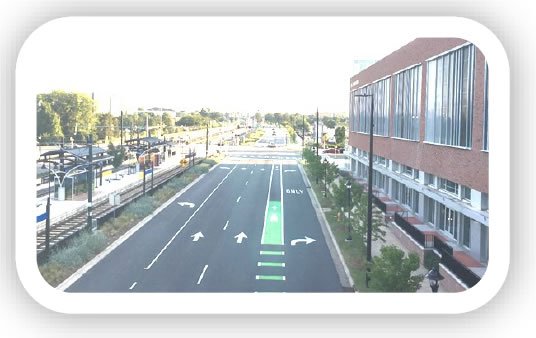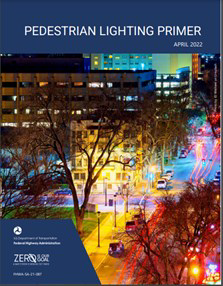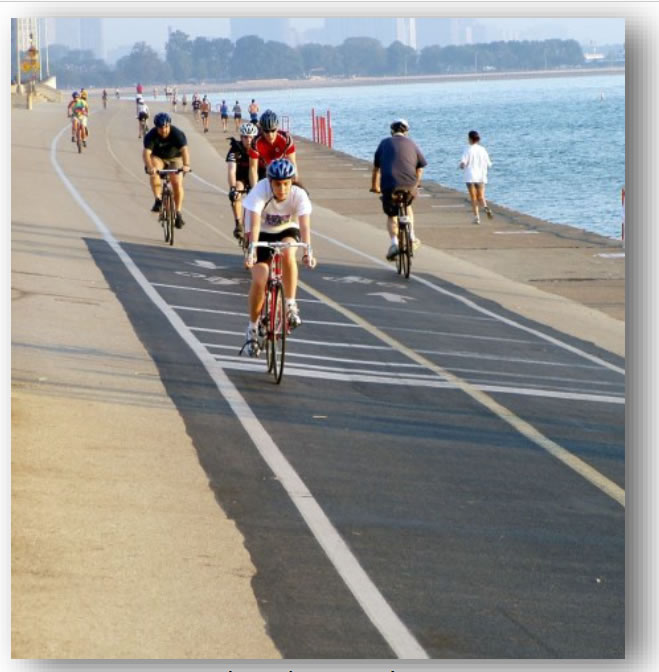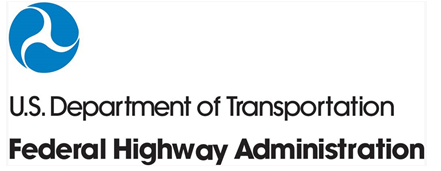U.S. Department of Transportation
Federal Highway Administration
1200 New Jersey Avenue, SE
Washington, DC 20590
202-366-4000

Photographer: Dan Burden
www.pedbikeimages.org/

U.S. Department of Transportation
Federal Highway Administration
Summer 2022
Downloadable PDF [909 KB]
In this issue:
NEW! Complete Streets Report to Congress
Safe Streets and Roads for All Grant Program
NEW! Improving Intersections for Pedestrians and Bicyclists: Informational Guide
NEW! Pedestrian Lighting Primer
The National Highway Traffic Safety Administration (NHTSA)—which is part of the United States Department of Transportation (U.S. DOT)—released its 2020 (the earliest year for which complete crash data is available) annual traffic crash data showing that 38,824 lives were lost in traffic crashes nationwide. That number marks the highest number of fatalities since 2007. In addition, bicyclist fatalities were up 9.2% (from 846 to 891— the highest number since 1987) and pedestrian fatalities were up 3.9% (from 6,412 to 6,721—the highest number since 1989).
NHTSA also published early estimates for 2021 roadway fatalities. The total projected pedestrian fatalities increased by 13 percent from 2020 to 2021 and bicyclist fatalities increased by 5 percent from 2020 to 2021. These increasing numbers are alarming, but the U.S. DOT released two plans this year to help combat this growing national problem.
In April, U.S. DOT Secretary Pete Buttigieg announced the FY 2022-26 U.S. DOT Strategic Plan, which is a roadmap for achieving the U.S. DOT’s mission: to deliver the world’s leading transportation system, serving the American people and economy through the safe, efficient, sustainable, and equitable movement of people and goods.
This plan outlines six DOT Strategic Goals: Safety, Economic Strength and Global Competitiveness, Equity, Climate and Sustainability , Transformation, and Organizational Excellence.
The National Roadway Safety Strategy (NRSS), a roadmap for addressing the national crisis in roadway fatalities and serious injuries, was also released earlier this year. The NRSS contains several key action items. The ones most relevant to vulnerable road user safety are:
“We cannot tolerate the continuing crisis of roadway deaths in America. These deaths are preventable, and that's why we're launching the National Roadway Safety Strategy today - a bold, comprehensive plan, with significant new funding from President Biden's Bipartisan Infrastructure Law.”
-U.S. Transportation Secretary Pete Buttigieg.
The Federal Highway Administration (FHWA) completed Moving to a Complete Streets Design Model: A Report to Congress on Opportunities and Challenges in early March. The Report identifies recent FHWA rules, guidance, and resources that affect safety and access for the users of all surface transportation modes, as FHWA moves ahead with its effort to implement a Complete Streets design model. A Complete Street is safe, and feels safe, for all users, and routinely. FHWA is focused on making Complete Streets its default approach as it supports transportation agencies in planning, developing, and operating equitable streets and networks that prioritize safety, comfort, and connectivity to destinations for everyone using the street network.
As background, FHWA early last year established a Complete Streets initiative that seeks to work with State, Tribal and local transportation agencies across the U.S. to implement Complete Streets policies adopted by State and local governments across the country. The FHWA’s Complete Streets initiative works to ensure that the agency plays a leadership role in the process of providing and equitable and safe transportation network for travelers of all ages and abilities, including those from underserved communities that have faced historic disinvestment.
The FHWA’s Complete Streets efforts focus not just on policy but on outcomes, including increasing the proportion of Federal-aid funded transportation projects that are routinely planned, designed, built, and operated as Complete Streets. The findings of the Report to Congress are helping guide FHWA’s next steps. A new web portal has been established, and web visitors will find a set of cross-sections showing Complete Streets Transformations. Future activities include:
“We face a national crisis of fatalities and serious injuries on our roadways, and these tragedies are preventable— so as a nation we must work urgently and collaboratively to save lives. The funds we are making available today from President Biden’s Bipartisan Infrastructure Law will help communities large and small take action to protect all Americans on our roads.”
-U.S. Transportation Secretary Pete Buttigieg
BIL established the new Safe Streets and Roads for All (SS4A) discretionary program that will provide $5 billion in grants over the next 5 years. The primary goal of SS4A grants is to improve roadway safety by supporting communities in developing comprehensive safety action plans based on a Safe System Approach, and implementing projects and strategies that significantly reduce or eliminate transportation-related fatalities and serious injuries.
The Notice of Funding Opportunity (NOFO) for the the SS4A Program has been posted and will be open through September 15, 2022. The purpose of this notice is to solicit applications for SS4A grants. Up to $1 billion in funds for the fiscal year (FY) 2022 grant program will be awarded to regional, Tribal and local jurisdictions on a competitive basis to support development of Comprehensive Safety Action Plans, and implementation of those plans to prevent death and serious injury on roads and streets involving all roadway users, including pedestrians; bicyclists; public transportation, personal conveyance, and micromobility users; motorists; and commercial vehicle operators. Please share the NOFO announcement with your regional, local, and Tribal partners; and visit the SS4A website for more information, including frequent webinars to help applicants.
The SS4A program supports Secretary of Transportation Pete Buttigieg’s National Roadway Safety Strategy (mentioned on page 1 of this newsletter) and a goal of zero deaths and serious injuries on our nation’s roadways.

Source: FHWA
FHWA completed the Improving Intersections for Pedestrians and Bicyclists: Informational Guide. The purpose of this guide is to inform the state of the practice concerning intersection planning and design to implement solutions that help achieve the goal of zero fatalities and serious injuries while also making roads better places for walking and bicycling. All types of intersections can facilitate safe, accessible, convenient, and comfortable walking and bicycling when designed with pedestrians and bicyclists in mind.
This guide serves as a supplement to the FHWA’s series of intersection informational guides and makes direct connections to other FHWA bikeway and pedestrian facility selection guides. Part I presents three foundational principles for planning and designing intersections for pedestrians and bicyclists. Part 2 presents design concepts for each of the intersection types discussed in this guide and illustrates options and design flexibility for incorporating a variety of pedestrian and bicycling facility types.
In addition, FHWA has produced a set of one-page, handout-style documents illustrating various pedestrian and bicyclist facility alternatives and considerations at the different intersection designs covered in the guide. For more information contact Jeffrey.Shaw@dot.gov..
The FHWA Office of Safety will be holding a webinar high- lighting several new resources on Lighting for Pedestrians on Tuesday July 19 from 1-2:30 (EST). The webinar will dis- cuss the importance of street lighting on pedestrian safety by sharing the research outcomes from the Research Report: Street Lighting for Pedestrian Safety and provide an overview of the Pedestrian Lighting Primer. Click the link below to register:

FHWA published the Pedestrian Lighting Primer to be a resource for transportation practitioners interested in the safety and security benefits of pedestrian lighting as well as lighting design considerations at locations with existing or future pedestrian activity. Lighting of pedestrian facilities plays a key role in increasing the safety performance of the road network for all users.
Lighting not only makes it easier for drivers to see pedestrians, but also improves pedestrians’ abilities to see their surroundings and detect trip hazards. Lighting increases pedestrians’ perceived levels of safety and security associated with the use of pedestrian facilities. Lighting may also increase pedestrians’ confidence in performing certain tasks, such as assessing and selecting appropriate gaps at uncontrolled crossings and monitoring vehicles approaching and making different movements through signalized intersections. The primer has five sections:
For more information contact Joseph.Cheung@dot.gov.

Photographer: Dan Burden
www.pedbikeimages.org
FHWA recently announced new guidance and increased funding that can help state and local governments carry out projects that create safer, more walkable streets, including pedestrian and bicycle infrastructure, Safe Routes to School programs, and other local community projects.
BIL nearly doubled funding for the Transportation Alternatives (TA) Set- Aside, from $850 million annually for fiscal years 2018 through 2020 to an average annual amount of $1.44 billion from 2022 through 2026. The TA Set-Aside program can be used for a variety of projects including pedestrian and bicycle facilities, recreational trails, Safe Routes to School projects, road safety assessments, community improvements such as historic preservation and vegetation management, and environmental mitigation related to stormwater and habitat connectivity.
Given the high demand for these types of projects at the local level, the program also allows states to develop a process to suballocate up to 100 percent of funds to counties, metropolitan planning organizations (MPO’s), and regional transportation planning organizations. The law also requires states to hold a competitive grant process for local governments and other eligible entities before transferring TA set-aside funds to other Federal-aid programs.
The guidance also encourages states and MPO’s to incorporate demographic information into their TA Set-Aside program application and selection procedures as they prioritize projects to better measure transportation equity and address the needs of underserved communities.
More information about FHWA’s Transportation Alternatives Set- Aside Guidance can be found on FHWA’s web site and fact sheet.

Tamara Redmon, Pedestrian Safety Program
Manager
Federal Highway Administration
1200 New Jersey Avenue SE
Room E71-303
Washington, DC 20590
Phone: 202-366-4077
Fax: 202-366-3222
E-mail: tamara.redmon@dot.gov
This Pedestrian and Bike Forum is available on the Web at http://safety.fhwa.dot.gov/ped_bike/pedforum/
To receive information on future newsletters, please use the e-subscription service provided on this site: https://public.govdelivery.com/accounts/USDOTFHWA/subscriber/new?topic_id=USDOTFHWA_102

